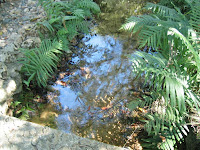
"Balong, sama ka sa bukid ipapastol ko ang kalabaw?", paanyaya ni Tiyo Silo.
"O sige pero maglalakad na lang ako."
"Medyo malayo iyong pastulan, sakay na lang tayo sa kalabaw. Sa likod ka, ako ang magda-drive", sambit ni Tiyo Silo.
Inalis ni Tiyo Silo ang tali ng kalabaw sa puno ng mangga. Nakita ko ang mabait na kalabaw na nakangiti dahil alam niya na sa ganitong oras ay dadalhin na naman sa kanyang paboritong lugar upang kumain ng iba't ibang klaseng damo.
Magaan ang loob namin sa kalabaw. Kasali siya sa aming pamilya. Siya ang ginagamit pang-araro sa bukid. Hinihila niya ang kariton na may mabibigat na sako ng palay patungo sa bahay ni Lola Kolasa. Sinasakyan namin ang kariton para pumunta sa bayan at mamalengke. Matiyaga ang kalabaw, kaya pinapakain namin siya ng maigi.
"Tiyo, 'di ko alam umakyat sa kalabaw, paano ako makasasakay?" Dahil ako'y apat na taon pa lamang noon ay binuhat ako ni Tiyo at inilagay sa likod.
"Huwag kang matakot, hawakan mo sa likod", wika ni Tiyo.
Inalagay ni Tiyo Silo ang mga kamay sa likod ng kalabaw na iyong isa ay hawak ang tali at sabay talon sa kalabaw. Ilang saglit ay nakasakay na kami. Lumalakad na si matiyagang kalabaw. Masayang masaya siya.
"Maaaaaaaaaaaak..", sigaw ng kalabaw.
"Aray!", nadama ko ang hampas ng buntot ng kalabaw tatlumpong segundo lang bago kami lumisan. Hinayaan ko iyong unang hampas kasi alam kong gaya ng aso ay nagpapahiwatig ng kagalakan. Ngunit sinundan pa ng napakaraming pagkilos ng buntot ng aming babaeng kalabaw.
"Tiyo, masakit ang hampas ng buntot", habang lasap ko ng kasarapan ng pagsakay.
"Magtiis ka, malapit na tayo".
Nang makarating kami sa pastulan, unang bumaba si Tiyo para ilagay iyong kahoy na doon nakatali. Ipinukpok niya sa lupa at hinayaan ako sa kalabaw. Matindi kong hinawakan ang likod ng hayop dahil ayaw kong mahulog. Gayundin, natatamaan pa rin ako ng buntot.
Natapos na ng pagpukpok si Tiyo at lumakad siya papalapit sa amin. Ibinaba niya ako.
Hinayaan namin ang kalabaw at pumunta kami sa bahay-kubo na kung saan nandoon si Lola Kolasa. Habang nilalasap ko ang simoy ng hangin, nakatingin pa rin ako sa kalabaw. Napansin ko na hanggang ngayon ay gumagalaw pa rin ang buntot.
"Lola, bakit gumagalaw ang buntot ng ating kalabaw?", di ko na mapigilang magtanong.
"Itong Apo ko, kung anu-anong itinatanong", wika ni Lola. "Kasi maraming langaw ang dumadapo sa puwit, kaya ginagamit ang buntot na pamaypay".
May mga pangyayari sa barrio na hindi maaaring kalimutan. Ang pagsakay sa kalabaw na kasama ang hampas ng buntot nito ay walang katapusang karanasan itinatago sa puso.
*****
A smaller breed of Water buffalo, the Carabao, is the national animal of the Philippines.
The carabao (Filipino: kalabaw) or B. bubalus carabanesis is a domesticated subspecies of the water buffalo (Bubalus bubalus) found in the Philippines, Guam, and various parts of Southeast Asia. Carabaos are highly associated with farmers, being the farm animal of choice for pulling the plow and the cart used to haul farm produce to the market.
 Carmen Rosales (born 1918 in Pangasinan) is a famous prewar Filipina actress better known as Mameng and is noted for her skill in acting and sweet voice. Rosales' film debut was in the 1938 movie Ang Kiri which she made a double to Atang dela Rama. When her friend brought her to Quisumbing the man rejected Rosales because the young woman did not have an aura of an actress.
Carmen Rosales (born 1918 in Pangasinan) is a famous prewar Filipina actress better known as Mameng and is noted for her skill in acting and sweet voice. Rosales' film debut was in the 1938 movie Ang Kiri which she made a double to Atang dela Rama. When her friend brought her to Quisumbing the man rejected Rosales because the young woman did not have an aura of an actress.





























